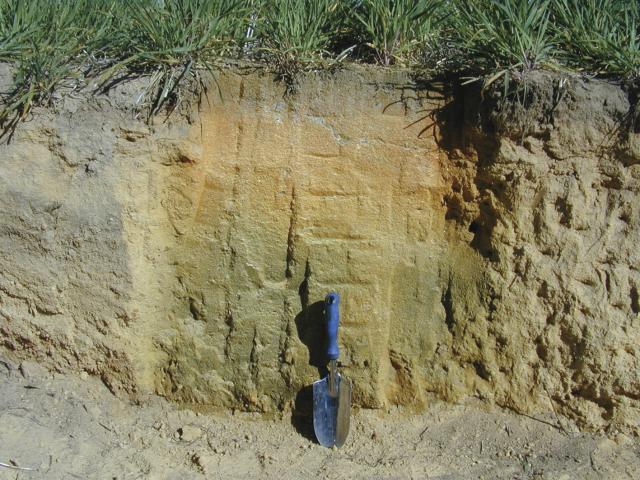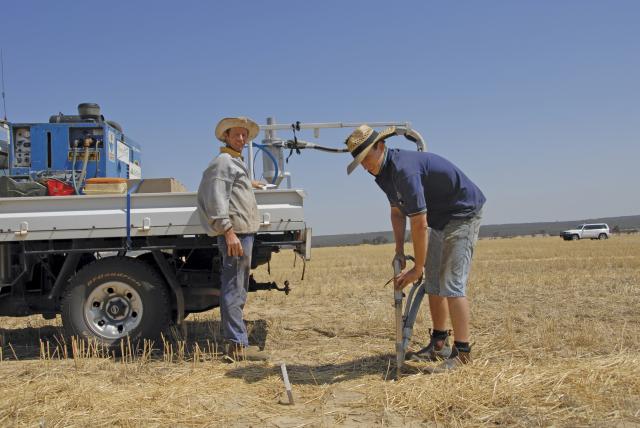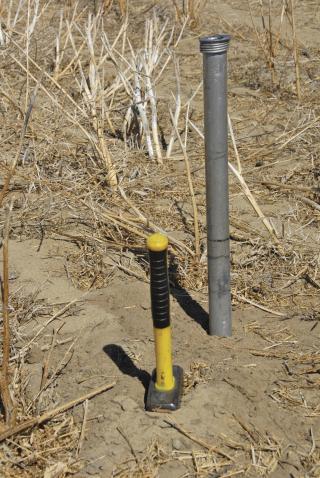Soil sampling
Topsoil pH can be quite different from the subsurface soil pH (Figure 1) and sampling only the topsoil may lead to inadequate lime applications. Acidity in the subsurface cannot be detected or estimated by knowing the topsoil pH. Samples should be taken at 0-10, 10-20 and 20-30 centimetres (cm) to determine a soil pH profile.

Ideally, soil samples should be taken in summer, when most soils are hot and dry with minimal biological activity. This will minimise the impact of seasonal variations in pH, which will be further reduced by measuring pH in a calcium chloride solution rather than water.
Paddock variability, particularly soil type changes, should be taken into account when designing sampling programs. It is important not to under-sample; knowing and understanding ‘management areas’ within paddocks will allow targeted lime inputs to maximise economic return. For example, clay soils are generally slower to acidify but require more lime to lift pH when they become acidic.
Commercial contractors
The best option is to use a specialised soil-sampling contractor and seek expert advice for individual liming recommendations (Figure 2). Professional soil-sampling contractors should geo-locate sampling sites and arrange laboratory testing of the samples. They may also provide record-keeping services and liming recommendations. Sampling for soil pH testing is often done in conjunction with soil nutrient sampling for fertiliser recommendations.

Do-it-yourself sampling
A do-it-yourself approach to soil sampling is possible. Divide the paddock up according to soil type and areas that have different crop or pasture growth. Typically, 6-8 sample sites per paddock is adequate, with representative sites from each soil type or management area in the paddock. If the paddock is uniform, a grid pattern can be used or evenly space sites over the whole paddock.
Avoid unrepresentative areas such as stock camps, paddock corners and harvest windrows. Collect cores from around each site and bulk them into one sample, keeping the 0–10, 10-20 and 20-30cm layers separate and being careful to prevent topsoil contamination of the subsurface samples.
Traditionally, soil sampling has been done with a 'pogo stick' sampler, designed to sample the top 10cm of soil. This type of sampler is unsuitable to sample the 10-20 and 20-30cm soil layers that are necessary for soil pH sampling. A 5cm diameter exhaust tube, marked in 10cm increments, is a suitable alternative (Figure 3).
Soil samples should be sent to a laboratory accredited with the Australasian Soil and Plant Analysis Council Inc and the pH measured in a one part soil to five parts 0.01M calcium chloride solution (measurement of pH). All recommendations are based on pH measured in calcium chloride and designated pHCa.
Do-it-yourself soil sampling has a number of drawbacks; it requires a dedication to the task and inputs of time for sampling, arranging laboratory testing, sourcing liming recommendations and accurate record keeping to enable comparable repeat sampling over years for monitoring pH change.
Commercial soil sampling kits
Prepaid commercial soil sampling kits are available and may be the most convenient method for the do-it-yourself approach as they include full instructions, sample bags, postage and laboratory testing of the samples. These kits are primarily aimed at topsoil sampling and testing for fertiliser recommendations, but the subsurface 10-20 and 20-30cm layers may be sampled for pH at the same time (a suitable sampling tube, or commercial soil sampling contractor able to accurately sample the subsurface, will need to be used).
Field pH testing
Laboratory testing of pH provides the most accurate measurement of soil pH. Field testing with a hand-held pH probe may provide an indication of areas that need accurate soil sampling and testing. Hand-held pH probes are available from scientific equipment suppliers and come with instructions.
When field testing soil pH, it is usually more convenient to use deionised or distilled water instead of 0.01M calcium chloride and so the results will need to be converted by subtracting 0.7. It is important to maintain the probe in good condition and calibrate with standard pH buffer solutions each day it is used.
Soil pH test kits that use indicator solutions and colour to estimate pH are inexpensive and easy to use. However the results are subjective and should be used with caution. The chemicals used with the kits are subject to deterioration.
Electro-magnetic (EM) mapping
Elecro-magnetic (EM) mapping shows soil type variability across the farm. While soil type does influence the pH of the soil and the acidification rate, EM mapping cannot take into account the farming and liming history of the soil. The pH will differ according to how long the soil has been farmed, what type of farming has been conducted and how much and how often lime has been applied. Consequently, the relationship between EM results and current soil pH is variable.
Monitoring soil pH
Monitoring changes in soil pH is an important part of soil acidity management. Re-sampling every three to four years will enable you to refine your liming program, to prevent good soil from becoming acidic and avoid liming unnecessarily on soil that doesn’t need it.
Because pH can vary within a paddock, tracking changes in the soil pH requires samples to be collected from the same location over time. Samples need to be properly geo-located, preferably by GPS, to allow comparable repeat sampling.
Sampling 25% of a farm each year enables a four-year rotation. This is an adequate time frame to detect changes and allow adjustment of liming practices.


